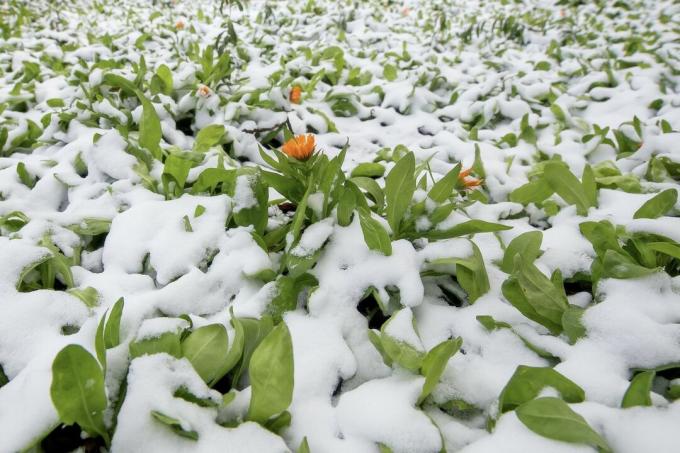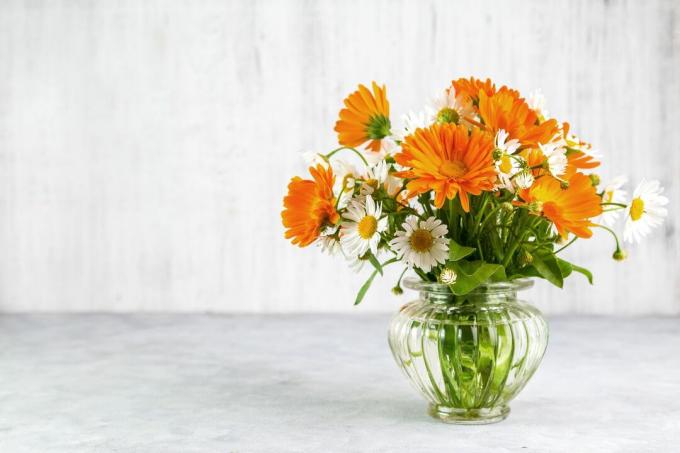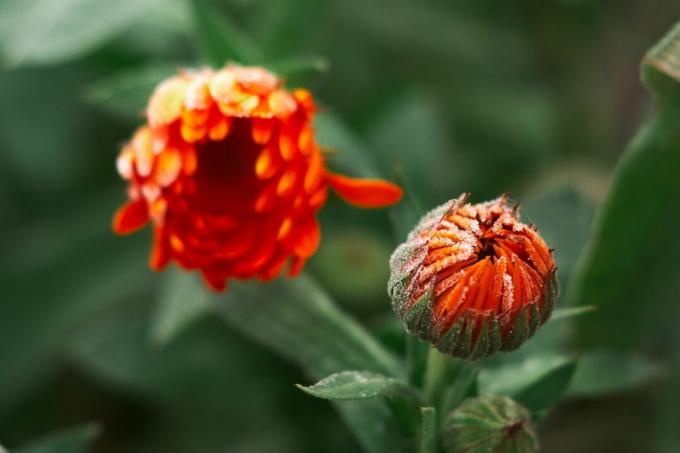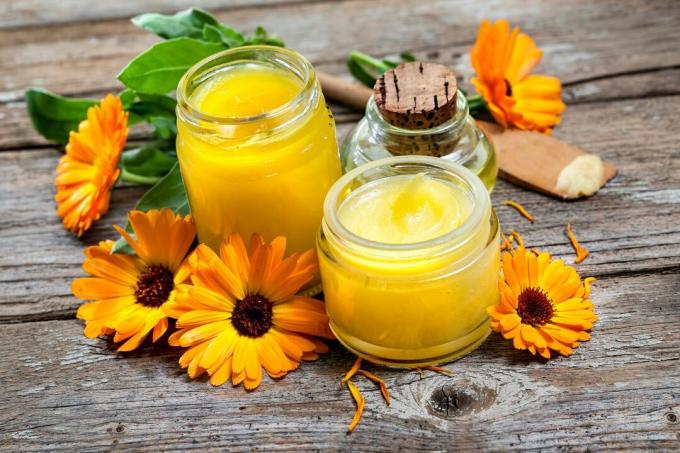The marigold has long been part of the image of old farmhouses and vegetable gardens. Due to its versatile use, the calendula not only delights with its beautiful blossom.

It is not only a valuable plant for bees, wild bees and butterflies due to its good pollen and nectar values, we can also benefit from it. We present you the marigolds (Calendula officinalis) and give tips for cultivation in your own garden. We also go into other aspects such as use.
"Contents"
- Marigold: characteristics and origin
- The most beautiful types and varieties of marigolds
-
planting marigold
- The right location for calendula
- Marigold as green manure against pests
- Caring for marigolds: cutting, watering & Co
- Is the marigold hardy?
- Harvesting marigolds: when and how to do it
-
Use of Marigold
- Marigold as a medicinal plant
- Is the marigold poisonous?
Marigold: characteristics and origin
The marigold, also called gold flower, rain flower or marigold, belongs to the daisy family (Asteraceae). It has been with us for so long that it is not possible to say with certainty where it originally came from. Botanical studies suggest an origin in the Mediterranean region. Perhaps the Crusades at the end of the 11th century Century contributed to its spread. So the marigold is a neophyte. However, because it doesn't crowd out other plants or multiply excessively, we don't classify it as problematic or invasive.
Today, the plant grows primarily where there is nutrient-rich and loose soil. At the end of its flowering period, the annual golden flower develops seeds that fall down and into the ground overwinter in order to produce new 20 to 60 cm high yellow-orange flowering plants in the next growing season bring forth. The non-toxic Calendula blooms from June to October and can be used in many ways during this time. For example, the marigold can be used as a home remedy to treat wounds or to reduce inflammation.

The most beautiful types and varieties of marigolds
The different varieties of marigold are often only distributed locally. Here are some particularly beautiful representatives of the marigold:
- 'Orange Gitana': A rather short cultivar that produces orange flowers
- 'Yellow Gianna': Maize yellow flowers with darker pistils
- 'Orange Porcupine': Full, orange flowers that are often curled up
- 'Neon': Densely double orange flowers with red tips
In addition to varieties of Calendula officinalis there are also related species of calendula that can be decorative and useful. An example is Calendula arvensis, which is considered the ancestor of the cultivated marigold and is just as easy to cultivate.
In addition to pure seeds, there are also many seed mixtures for flower meadows available that combine the bee magnet calendula with other summer flowers. With such insect-friendly mixtures you can offer food to numerous different insects.
planting marigold
Whether as an eye-catcher between the vegetable plants, as part of an insect pasture or for targeted harvesting - the marigold is diverse. We will show you how you can plant the calendula in your garden.

The right location for calendula
The marigold likes to stand on fresh to moist, loamy and nutrient-rich soil. Unfortunately, heavy soils that tend to waterlogging are unsuitable for marigolds. In March to May, or early autumn at the latest, you can sow them in a sunny to partially shaded spot outdoors or in a bucket. You can also grow the calendula in a pot to keep a valuable plant for humans and insects on your partially shaded to full sun balcony.
Important: When cultivating in a pot, water drainage must be guaranteed through holes in the pot.
In order for marigold seeds to germinate, it is crucial to keep the germinating seed moist.
Sowing marigolds at a glance:
- Sowing date: April – October
- Germination time: 8 - 14 days
- Germination temperature (optimal): 10 - 20 °C
- Sowing depth: 1 - 2 cm
- Row distance: 20 - 30 cm, the distance also applies to other crops
- Planting distance: After emergence, separate to 25 cm

For sowing, we recommend loose soil with a low nutrient content, which stimulates root formation and allows the plant to grow optimally. For example ours Plantura Organic Herb & Seed Soil works well here. The perlite in the soil ensures a loose soil structure.
Marigold as green manure against pests
But the medicinal plant not only has something to offer for humans and insects. She can also improve the soil. For example, if this is infested with harmful nematodes (also called roundworms or nematodes), marigold plants act as a natural soil disinfectant against many types of roundworms. You sow 1.5 grams of marigold seed per square meter between March and September and leave the flowers for at least ten weeks before you can work them into the soil. Since harmful nematodes often occur in tomatoes and carrots, the marigold is a good choice as a cover or side crop.
tip: Not all nematodes are pests, in fact there are useful nematodesthat are used in biological crop protection.

Caring for marigolds: cutting, watering & Co
As an adult plant, the calendula can withstand some dry periods. However, if the soil is visibly dry, it should be watered. However, waterlogging is not tolerated by the plant. If the marigold grows by self-sowing in the same place for several years, fertilization is necessary. This can already be taken into account when sowing by incorporating a long-term fertilizer into the seedbed. With our Plantura organic flower fertilizer achieve a long-term effect of at least three months. The balanced nutrient composition ensures healthy and resilient plants. The slowly and fluently released nitrogen as well as the rather low phosphate and high potassium content of our flower fertilizer suit the stability and blooming joy of marigolds.
The long-stemmed flower is suitable as a cut flower for the vase and brings the joy of colorful nature into the house from summer to autumn.
When growing in pots, fertilizing every six weeks is recommended, the easiest way to do this is with an organic liquid fertilizer. However, pay attention to the nutrient composition: Fertilization that is too high in nitrogen significantly reduces flowering. Our Plantura organic flower & balcony fertilizeron the other hand, ensures lush flowers throughout the season. The microorganisms contained are introduced into the soil by the quick and easy pouring application. These in turn promote strong root growth. The nutrient composition of our fertilizer is specially designed for flowering plants and provides the right amount of important nutrients.

Caring for marigolds at a glance:
- Water when dry, but avoid waterlogging.
- Use a slow-release fertilizer annually outdoors and for perennial crops in the same location.
- In pot culture, regular fertilization is necessary.
Is the marigold hardy?
Since the calendula is an annual summer flower, the plant cannot be overwintered. If the temperatures do not drop below -5 °C, the radiant flowers of the marigold can still be seen. If it gets even colder, the plant stops growing altogether. Therefore, the flower can be classified as sufficiently frost hardy. The seeds that the marigold sheds at the end of its vegetation period also survive the cold months in the ground. In the spring, these produce new plants, so that with a bit of luck you can enjoy the calendula again.
Tip: You can also specifically collect the seeds while they are still maturing on the plant. Ripe seeds can be recognized by the fact that they are dry and can be easily detached from the seed head, which is also dry.
If you sow the calendula late in the year, it will definitely still be there in bloom in winter. The seeds can then be used to propagate your own marigold stock elsewhere in the garden or to propagate in new pots.

Harvesting marigolds: when and how to do it
For medicinal use of the plant, the best time to harvest is when it is in bloom, as the fully developed flowers are used. Often only the flower heads are used, which you can easily snap off with your fingers. Anyone who is enthusiastic about wild herbs will also find the leaves interesting. These can be harvested all year round. However, you should not remove all leaves from a plant to allow it to regenerate.
Use of Marigold
The different parts of the marigold have different uses:
- Leaves: salad ingredient
- Flower heads: decoration for salads, coloring agent for rice or Easter eggs, cooking in ointments
- Petals: Dried as a tea
- Peduncle and flower: cut flower

Because it is an insect friendly plant, bees are often found perched on marigolds. To use as a cut flower, cut off the loveliest shoots far down, preferably with the flowers that have just opened. Make sure that no leaves in the vase are submerged in the water.
Marigold as a medicinal plant
The most well-known form of the calendula remedy is the ointment, which you can also make yourself. Marigold flower heads are lightly boiled with beeswax and sunflower oil. Vaseline or milking grease can also be used as a basis. This is then used in areas of wound healing and joint pain. It also helps against pimples, dry skin or dermatitis and is also said to be useful against stretch marks.

Is the marigold poisonous?
As can already be seen from the sections above, the marigold is not poisonous to humans.
For dogs and horses, for example, there are remedies made from calendula, such as teas or oils for use in the gastrointestinal tract or for the coat.
For cats, however, the essential oils contained in marigolds are unfortunately toxic. Learn about other plants you can plant in your garden. More exciting Medicinal plants for the garden we have put together for you in our special article.



